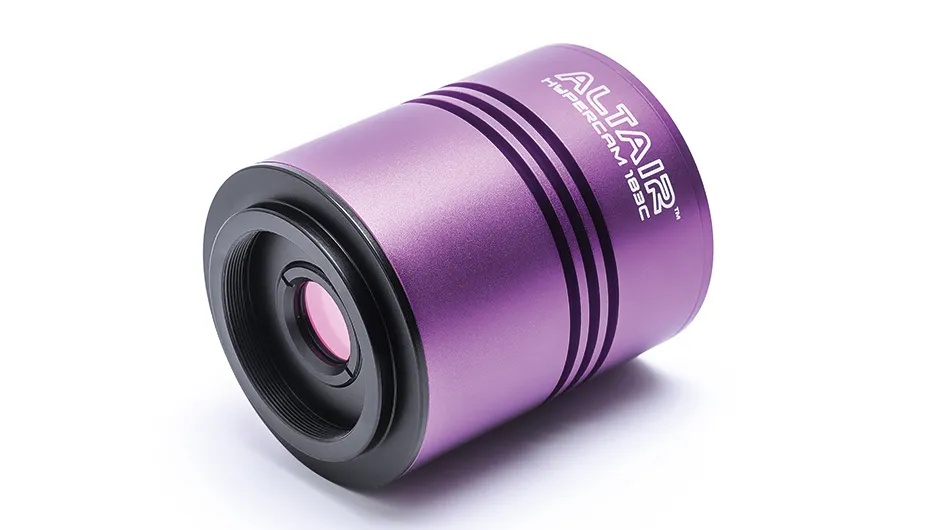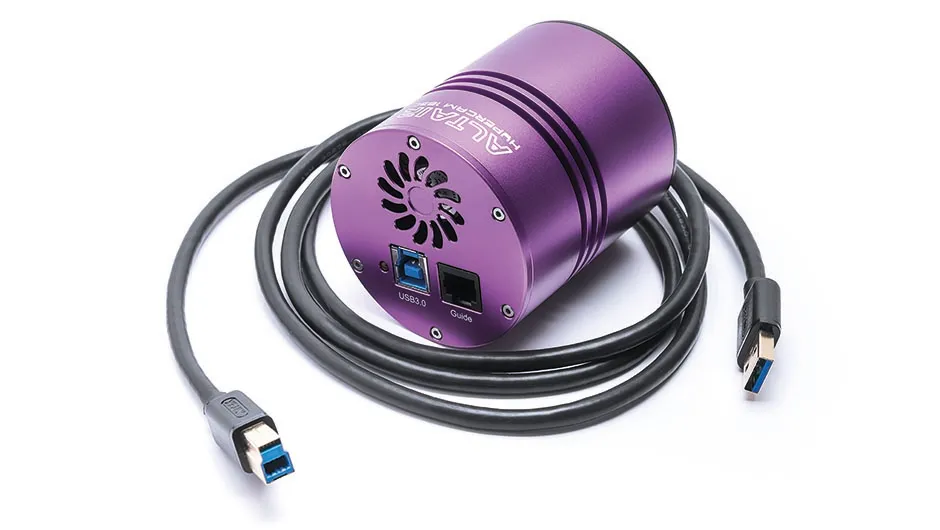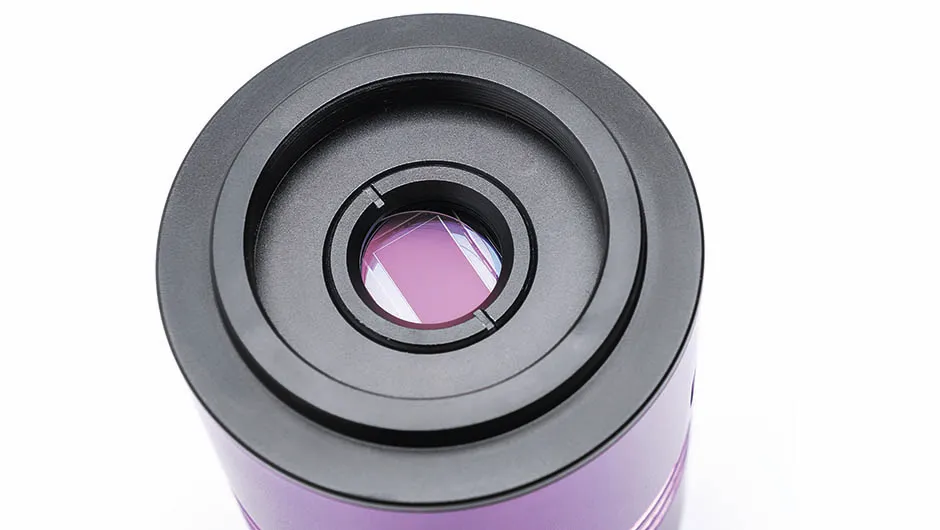Price: £550.00
Weight: 300g
Supplier: Altair Astro
Telephone: 01263 731505
Website: www.altairastro.com
A regular request from astronomers is for a single camera that will allow them to photograph both Solar System and deep-sky objects, and the 20-megapixel IMX183 USB 3.0 colour camera from Altair Astro is a great stride in that direction.
The camera weighs in at just a third of a kilogram, requires no separate power supply and offers appealing features for travelling astronomers.
Downloading and installing a driver package is the only setting up required before you plug the USB 3.0 cable in.
Our observatory uses USB 2.0 hubs and the IMX183 automatically recognised this and adapted accordingly, although at the cost of slower data transfer due to the USB 2.0.
For this review we chose a capable 6-inch (f/7) triplet refractor as a match for the camera.
We downloaded the free AltairCapture control software to test the Hypercam IMX183.
In simple terms, the camera offers three resolutions, with a bit depth of eight or 12 bits.
Depending on the choice of target, select either the video mode to record a video file or ‘trigger’ mode to capture a series of individual pictures in the FITS format.
In 12-bit mode, the highest resolution (5,440x3,648) will quickly create large and unwieldy video files, but restricting the region of interest (ROI) in the picture helps to avoid this.
Although USB 2.0 mode was more convenient for our purposes, the sacrifice in frame rate would be unacceptable if the camera was primarily to be used for planetary, lunar, or solar imaging.
Switching to USB 3.0 mode, we were able to achieve frame rates of 60 frames per second (fps) at the lowest resolution with ROI (930x688) in 8-bit mode.
Stepping up the resolution to maximum with the same ROI reduced the frame rate to 17.5fps on a reasonably capable laptop.

Pixel power
For deep-sky imaging we set the resolution and bit depth to maximum, turned down the gain setting to around five, and took a series of longer exposures of a variety of objects on the Messier list.
Although the pixels are a tiny 2.4x2.4µm, they are surprisingly sensitive, and the resulting images showed excellent star colours.
It was especially pleasant to clearly see the distinction between the hot blue and the smouldering red stars within globular M13 in Hercules.
Bright planetary nebulae such as M57 and M27 also showed good, natural looking colour, nicely defining the glowing hydrogen and oxygen regions within them.
Despite the warm evening air, exposures of up to five minutes displayed only minor amp glow, which is a brightening of the edges of the image.
This was easily negated by capturing dark frames.

One area this camera will excel at is the increasingly popular realm of ‘electronically assisted’ astronomy.
At public events where helping several people to view deep-sky targets is challenging, or for those who struggle to observe via a traditional eyepiece, the camera can display either live images of bright targets (the Moon, Jupiter, Saturn and so on) or nearly live short exposures of fainter objects (such as galaxies, bright nebulae and comets), on a computer screen.
It’s easy to see and share, you can zoom in and there’s no need for your viewers to wait for their eyes’ dark adaptation to settle in.
The rich, natural colours displayed by the stars enhanced the experience, which even seasoned astronomers will appreciate as offering an alternative and, dare we say, improved view to that which is available from eyepieces.
Jupiter too was rich in colour with a live view, several tones of browns visible in the bands and the distinct rusty orange of the great red spot clearly visible as it rotated into view.
Within the price range of a reasonable DSLR, with no need of modification for astronomy, the IMX183 offers a single camera solution to those who primarily wish to take deep-sky photographs, and also use the same camera and software for Solar System targets from time to time.
A pre-eminent sensor
The heart and soul of this camera is its CMOS sensor, the impressive Sony Exmoor R IMX183.
In-built technology allows for images with less unwanted noise and improved sensitivity.
Despite the massive 20-million pixel array, the diagonal size of the sensor is just 15.86mm across, making it easier to avoid problems with distortions from coma at the edges of the image and possibly removing the requirement for a field flattener with some telescopes.
If required, the sensor could easily be covered by 1.25-inch filters with no vignetting.
With a possible exposure range of 0.26 milliseconds to over 16 minutes, and adjustable gain, the camera is flexible enough to cater for almost every conceivable object that a telescope can resolve.
The gain setting, similar to ISO in some ways, offers increased sensitivity at the expense of more noise, and we were quickly able to determine optimal settings for various targets.
The front filter of the camera is also removable to allow the sensor to be cleaned if necessary.

Cooling fan
Temperatures inside a camera can make a big difference to the final picture quality.
A quiet fan attached to a large heatsink, in turn attached to the CMOS sensor itself, helps the IMX183 to avoid a build up of unwanted heat and to maintain a more stable imaging environment.
Guide port
With such impressive sensitivity on offer, the Hypercam IMX183 can double up as a guide camera should the need arise, and has an output port on the rear of the casing for an ST-4 cable (included), allowing the camera to communicate directly with a range of telescope mounts.
Optical window
By blocking unwanted infrared and ultraviolet rays from reaching the camera sensor, the optical window helps to ensure a sharper image is produced.
In front of this window is a standard T-thread (M42) attachment ring, for the 2-inch nosepiece supplied, with threaded dustcap to protect the optical surface.
AltairCapture software
Available for free download, this accomplished software allows full control of the camera within an easy to grasp framework.
Intuitive on-screen sliders simplify video capture, image sequences, and image previews.
We particularly liked the ease of finding perfect focus using a Bahtinov mask and zoomed in live view mode.
USB 3.0
A 1.8m high-speed cable handles the job of transferring each 20-megapixel frame from the camera to the controlling computer as quickly and cleanly as possible.
The dedicated USB 3.0 port on the rear of the camera plugs into a standard USB port, allowing compatibility with USB 2.0 equipment and hubs.
This review originally appeared in the August 2017 issue of BBC Sky at Night Magazine.
